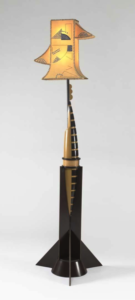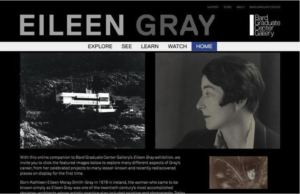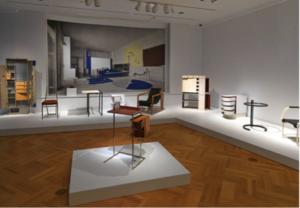Eileen Gray Goes Digital at Bard Graduate Center Gallery
by Taryn Clary
Eileen Gray at Bard Graduate Center Gallery, curated by Cloé Pitiot, delves into the life and career of the eponymous architect and designer, whose pioneering contributions to modernism have long been overlooked in comparison to those made by her male counterparts. Pulling together around 200 works, many of which have never previously been exhibited, the show seeks to demonstrate the full scope of Gray’s oeuvre across disciplines of architecture, interior design, fine art, furniture, and textiles. Unfortunately just two weeks into the exhibition’s run on West 86th Street, the Gallery had to close its doors in compliance with Governor Andrew Cuomo’s “New York State on PAUSE” executive order.
“Having the Eileen Gray exhibition while the gallery is closed is a very big disappointment,” expressed the Gallery Director Nina Stritzler-Levine, “but in this time of the pandemic we have to keep things in perspective.” Without missing a beat, the staff rethought how to make the exhibition accessible on screens at home through an online companion. The concept of a digital project was not entirely new to the Gallery and graduate institute, which, in addition to being devoted to the study of decorative arts, design history, and material culture, has developed a Digital Media Lab led by Jesse Merandy to advance scholarship through new media. The gallery’s closure, as explained by Associate Curator Emma Cormack, “is what gave us the opportunity, and the necessity, of making it happen.”

Eileen Gray (1878-1976), “Rocket” floor lamp, 1923. Lacquer, wood, painted parchment shade (modern replacement), electrical parts. 73 x 20 ½ in. (185.4 x 52 cm). Virginia Museum of Fine Arts, Richmond, Gift of Sydney and Frances Lewis, 85.169a-c.
With the written content generated and objects installed, it became a matter of working backwards and filling in gaps as needed. “In order to get the website up and running as quickly as possible,” Merandy said, “the first thing we did was take stock of what we had in terms of labels and high-resolution pictures, and started to think about how we could use the organization of the exhibition to determine the look and the layout of the site.” This thought evolved into the final design, in which action terms such as “Explore” and “Learn” direct you to engage with the exhibition material in a myriad of ways.
First, transport yourself to the three-floor gallery on the Upper West Side with a scroll through images of each room, installed according to major phases of Gray’s career from her early years in Ireland to her most well-known architectural project, the modernist villa E 1027 in France. Within these images, individual objects can be clicked on for further information, as though you are drawing in closer to read a label. In this way the companion successfully brings viewers as near as possible to the experience of meandering through the show. Still, Merandy wanted something more “progressive” than an identical transfer of the physical exhibition to the online sphere: “using the digital platform and its strengths, what could we do that was different that could give the user further interaction with those objects?”
Different types of objects called for different forms of interaction, determined by a balance of curatorial choice and technological capability. For example, Gray’s intricately detailed, lacquered wood panel titled Oriental Mountebanks lent itself perfectly to a zoom feature, which enables visitors to analyze each figure’s place in the scene and appreciate Gray’s adeptness with the medium. This is one object in a section dedicated to “New Discoveries,” providing not only closer views, but also deeper insight into what aspects of Gray’s work were uncovered through recent research.

Eileen Gray (1878-1976), Oriental Mountebanks, before 1915. Lacquered wood, 15 1/3 x 62 ½ in. (38.7 x 158.7 cm). Collection of the Maryhill Museum of Art, 1939.1.
Beyond the limits of wall space and international loan logistics, the companion also provides an opportunity to view extensive archival material that would not have been featured in the exhibition otherwise. Perhaps the most significant example of this is the inclusion of portfolios that Gray assembled in 1956 to document her life’s work and that currently live in the collection of the National Museum of Ireland. Visitors can leisurely flip through pages of sketches, architectural plans, and photographs, an intimate way to get to know the projects that Gray considered particularly noteworthy.
The final facet of bringing the website to life involved working with Gallery Educators to weave in resources for remote learning. As public programs remain canceled indefinitely, features like the “Object Stories” audio guides replicate the experience of taking a tour, while a furniture collage game creates an event for the whole family. For those looking to venture even further in depth into scholarship, these activities are supplemented by recordings of a streamed symposium as well as excerpts from the exhibition catalogue published by Bard Graduate Center and Yale University Press. “From a knowledge production experience,” Stritzler-Levine described, “it’s exceptional the amount of content that’s offered and the clarity of how it’s presented.”

Eileen Gray (1878-1976), Drawing of Chambre à coucher boudoir pour Monte-carlo (Bedroom/Boudoir for Monte Carlo), 1923. Gouache, crayon. Musée des Arts Décoratifs, Paris, CD6251.
The Eileen Gray online companion is just one piece of the expanded virtual content available from the Gallery, which has been met with positive feedback. Drawing on user data, Cormack concluded, “I think people find that it’s an interesting resource to visit on a quick basis, just to look at a few things, but also a good place to return to and read chapters of the catalogue or listen to ten object stories in a row.” To encourage repeat visits, they have also planned a “periodic roll out of content to keep people coming back as they would for events.” These gradual additions, including a gallery tour video, a chronology, and an interactive graphic representation of Gray’s artistic networks in Paris, aim to keep the Gallery relevant in an increasingly crowded virtual museum world. Competing with fellow #MuseumFromHome options, Merandy explains, “it really is kind of a battle to be fresh and innovative to get visibility.”
While the Gallery’s reopening date has yet to be determined, Merandy is certain that this is just the beginning of their virtual exhibition initiatives: “This was kind of a test run for the future of what we want to do at B.G.C. involving digital humanities and how we deal with object-based studies online. It was a trial by fire, but we learned a lot about what things worked and when you have a good team it makes a difference.”
About The Decorative Arts Trust Bulletin
Formerly known as the "blog,” the Bulletin features new research and scholarship, travelogues, book reviews, and museum and gallery exhibitions. The Bulletin complements The Magazine of the Decorative Arts Trust, our biannual members publication.









